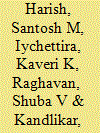| Srl | Item |
| 1 |
ID:
125766


|
|
|
|
|
| Publication |
2013.
|
| Summary/Abstract |
Karnataka has been among the most successful markets for solar lighting systems (SLS) among Indian states. In order to understand the dynamics of systems adoption and operation, that have fostered market based adoption of solar lighting, we interviewed rural households from six districts that had purchased solar lighting systems using loans at market rates, the rural banks that provided loans and the solar firms that marketed the technology. We found that a large proportion of households in our sample were connected to the grid but chose to install solar lighting because they considered the power supply from the grid to be unreliable. Households in our sample reported savings on electricity costs and reduced kerosene usage for lighting. In addition to providing credit, banks also play a key role in ensuring good service and maintenance; the viability of the SLS market is thus critically dependent on the role that the banks play as intermediaries between consumers and solar firms in rural areas. Government programs should be carefully designed to match the incentives of firms, banks and consumers if the successes of the 'Karnataka model' are to be repeated and amplified.
|
|
|
|
|
|
|
|
|
|
|
|
|
|
|
|
| 2 |
ID:
133084


|
|
|
|
|
| Publication |
2014.
|
| Summary/Abstract |
Despite frequent blackouts and brownouts, extension of the central grid remains the Indian government×s preferred strategy for the country×s rural electrification policy. This study reports an assessment that compares grid extension with distributed generation (DG) alternatives, based on the subsidies they will necessitate, and costs of service interruptions that are appropriate in the rural Indian context. Using cross-sectional household expenditure data and region fixed-effects models, average household demand is estimated. The price elasticity of demand is found to be in the range of ?0.3 to ?0.4. Interruption costs are estimated based on the loss of consumer surplus due to reduced consumption of electric lighting energy that results from intermittent power supply. Different grid reliability scenarios are simulated. Despite the inclusion of interruption costs, standalone DG does not appear to be competitive with grid extension at distances of less than 17 km. However, backing up unreliable grid service with local DG plants is attractive when reliability is very poor, even in previously electrified villages. Introduction of energy efficient lighting changes these economics, and the threshold for acceptable grid unreliability significantly reduces. A variety of polices to promote accelerated deployment and the wider adoption of improved end-use efficiency, warrant serious consideration.
|
|
|
|
|
|
|
|
|
|
|
|
|
|
|
|